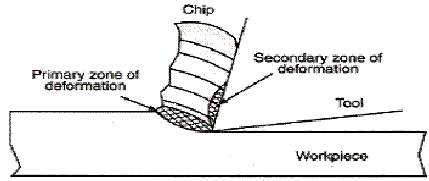INTRODUCTION TO METAL CUTTING:
Metal cutting is the process of producing a job by removing a layer of unwanted material from a given workpiece. Fig. shows the schematics of a typical metal cutting process in which a wedge shaped, sharp edged tool is set to a certain depth of cut and moves relative to the workpiece.
Under the action of force, pressure is exerted on the workpiece metal causing its compression near the tip of the tool. The metal undergoes shear type deformation and a piece or layer of metal gets repeated in the form of a chip.
If the tool is continued to move relative to workpiece, there is continuous shearing of the metal ahead of the tool. The shear occurs along a plane called the shear plane.
All machining processes involve the formation of chips; this occurs by deforming the work material on the surface of job with the help of a cutting tool. Depending upon the tool geometry, cutting conditions and work material, chips are produced in different shapes and sizes. The type of chip formed provides information about the deformation suffered by the work material and the surface quality produced during cutting.
Types of Chips:
Continuous chips: While machining ductile materials, large plastic deformation of the work material occurs ahead of the cutting edge of the tool. The metal of the workpiece is compressed and slides over the tool face in the form of a long continuous chip.
Discontinuous (segmented) chips: A discontinuous chip is a segmented chip produced in the form of small pieces. The discontinuous chips are produced when cutting brittle materials like cast iron, bronze and brass. The working on ductile materials under poor cutting condition may also sometimes lead to the formation of discontinuous chips.
Continuous chips with built-up-edge: The term built-up-edge refers to the small metal particles that stick to the cutting tool and the machined surfaces as result of high temperature, high pressure and high frictional resistance during machining. The building up and breaking down of the built-up-edge is periodic; its size first increases, then decreases and again increases-the cycle gets repeated rapidly.




4 Responses to “INTRODUCTION TO METAL CUTTING”
rakesh
effect of tool angles on forces
relation between cutting force, tangential force,shear force, frictional force
rake angle side cutting edge angle clerance angle nose radius
want to know more about merchant circle
Anyewi George
tool angle, rake anle, and angle of inclination are very important.
admin
Yes.. Of course.
mayank
hhhh